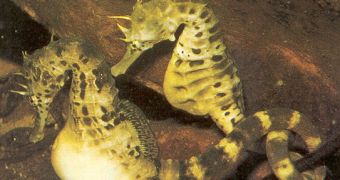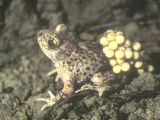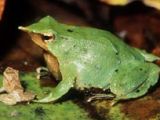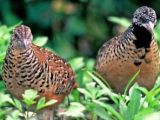As we all have learned, females produce eggs and males sperm. Females are the mothers and males are the fathers. This has been so ever since the beginning of times. The female takes care of the eggs and eventually of the offspring. And what if not? Nature has many surprises for us. Sometimes males are very devoted moms, while the females are hanging around, eventually fighting with other females to get more sex...This cannot happen in mammals, where the offspring depend on mother's milk. But the situation can go much further than egg defending seen in some fish species (like stickleback).
Here are some situations:
1. This is the most shocking: the male fishes of seahorses, pipefishes, weedy and leafy sea dragons (Syngnathidae) are the sex carrying the pregnancy!
This is unique and extreme in the animal world. The females of these fishes insert their ovipositors (like syringes) into a brood pouch on the male's chest and lay their eggs and the male then fertilizes and incubates the eggs. The pregnancies lasts 2-3 weeks. When the time comes, the daddy gives birth to independent offspring.
2. In southwestern Europe and Morocco the midwife toads (Alytes) are found. Their parental care gave them this name, but there is one detail: the midwife is the "midhusband". Or to be more precise, the father.
Their breeding behavior is unique: after mating, the males carry the strand of fertilized eggs on their back. After fertilizing them externally, the male wraps the eggs around his legs to protect them from predators in the water or drought. From time to time, the male soaks the eggs into water.
When the tadpoles are ready to hatch, the male wades into shallow water, where the tadpoles are released.
Leiopelma male frogs from New Zealand make the same with their eggs, from which new froglets hatch without a tadpole stage.
3. Darwin's frogs (Rhinoderma), two species from Chile, are another example of male mothers.
These frogs lay eggs on the ground and the male will engulf them and the tadpoles into its enlarged vocal sac. In one Darwin's Frog, the tadpoles are released into water to complete their development, while in the other completely formed froglets get out of the male's mouth. A male can carry 5 to 15 offspring.
4. In many species of unreated fish, after the eggs fertilization, the male takes the eggs into its mouth and keeps them well guarded till the emergence of the hatchlings. In some species, the male stays with the offspring even after they hatched and at the slightest signal of danger, the young take refuge in the male's mouth. This behavior is called paternal mouthbrooding (when it is exerted by females, it is called maternal mouthbrooding).
Families of fishes practicing the paternal mouthbrooders are arowana (Osteoglossidae) from Amazon, sea catfishes (Ariidae), cardinal fishes (Apogonidae), some cichlids (like Sarotherodon melanotheron), pikeheads (Luciocephalidae), lumpfishes (Cyclopteridae), jawfishes (Opistognathidae), some gouramis (Osphronemidae) like Betta pugnax.
5. In most birds, eggs are incubated by the female or both the female and the male. But in less than 1 % of the bird species this and offspring care are only the male's business.
The polyandry is a phenomenon found in nandu, cassowaries, some shore birds (like phalaropes), lily-trotters or buttonquails.
In the polyandrous species, the female mates with more males. Unlike in the case of the polygamous species (like peacock), where the male is the active sex, in this case is the opposite: the females are the active sex.
Females occupy the battlefield and chase away their weaker female rivals. Subsequently, only the bigger and brighter females will be fecundated by the males gathered around them and their descendants are more vigorous than the ones mothered by their rivals.
These females can be very aggressive and can destroy the eggs incubated by a male, just to make him incubate her eggs and raise her descendants. Typical for a male, isn't it? So, remember, next time you see a cassowary accompanied by a chicken, it is a he, not a she.
6.Discus fish (Symphysodon) and uaru (Uaru), two related genera of cichlid fish from the Amazon, have a very peculiar parental care. Not only the parents protect their brood, but they produce a secretion ("milk") through their skin, both males and females, off which the larvae live for 5 weeks.

 14 DAY TRIAL //
14 DAY TRIAL // 


